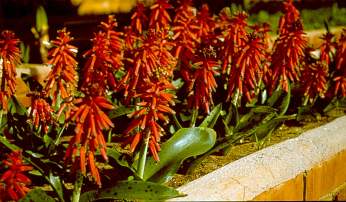Lachenalia bulbifera
Lachenalia bulbifera (Cyrillo) Engl.
Family: Hyacinthaceae
Common names: red lachenalia (Eng.); rooinaeltjie (Afr.)
Introduction
One of the most striking and robust members of this diverse group, Lachenalia bulbifera is an easily grown bulbous plant that really deserves a place in patio containers, window boxes and rock garden pockets.

Description
Description
Lachenalia bulbifera is a deciduous, winter-growing geophyte up to 0.3 m high. The subterranean storage organ is a shallow or deep-seated, fleshy, flattened bulb surrounded by membranous outer tunics. It produces one or two narrowly or broadly egg-shaped, fleshy, suberect leaves that may be plain green or heavily spotted or blotched with dark brown or purple on the upper surface.

The plant produces a sturdy, erect, plain or spotted flower stem covered with a delicate grey bloom. The numerous long, tubular flowers are pendulous and borne on short or long, red or orange flower stalks. The flowers are unscented and have a distinct perianth tube 6-8 mm long. Flower colour varies from pale to deep orange or red; occasionally pure yellow specimens also occur. The outer tepals have a dark red or brown swelling near the tip and the slightly longer inner tepals usually have green tips, flanked by two purple zones. The round black seeds have a shiny seed coat and are released from ellipsoid, papery capsules in late spring.
Conservation Status
Status
Lachenalia bulbifera is not threatened.
Distribution and habitat
Distribution description
Endemic to the western and southern coastal parts of the Western Cape, Lachenalia bulbifera usually grows in large colonies and is found on deep acid or alkaline sand dunes and flats, as well as on granite outcrops in gravelly clay and humus-rich soils. It grows in full sun or light shade and is often encountered flowering on sea-facing dunes just above the high water mark. The flowers vary in colour, length and flowering time, depending on wild locality; forms occurring in the southern Cape tend to flower from mid- to late autumn (April to May) and have relatively short, pale or dark orange flowers, whereas those from the West Coast and the Cape Flats flower in midwinter (June to August) and have longer flowers in various shades of red and orange.

Derivation of name and historical aspects
History
The genus name Lachenalia commemorates the Swiss botanist Prof. Werner de Lachenal (1739-1800) who was stationed at the University of Basel during the late 18th century. The specific name bulbifera is derived from the Latin words bulbi, meaning bulbs, and fero, meaning bearing or carrying, and refers to the bulbils that often develop along the leaf base margins in certain forms of this species. L. bulbifera was one of the first Cape bulbs to be introduced to Kew Gardens from material collected at the Cape by Thunberg in 1774, and was previously well known by its old name L. pendula Aiton.
Ecology
Ecology
The long, tubular flowers of Lachenalia bulbifera are specialized for pollination by sunbirds, especially lesser double-collared sunbirds (Nectarinia chalybea) that feed on nectar contained in the base of the perianth tubes. The sturdy flower stems of L. bulbifera are easily able to support the weight of visiting sunbirds that cling to the stems while probing the flowers for nectar.

Growing Lachenalia bulbifera
Grow
Lachenalia bulbifera is a rewarding species under cultivation provided a few simple points are borne in mind. The bulbs are deciduous and winter-growing, and are completely dormant during the summer months. They should be planted in early autumn (March to mid-April in the southern hemisphere). The top of the bulb should rest 2-3 cm below the surface. The growing medium must be well aerated and drain rapidly; a recommended soil mixture is equal parts of finely sifted, well-decomposed compost and river sand/silica sand (swimming pool sand), and it is best to plant the bulbs in a layer of pure river sand or silica sand. An ideal aspect is one receiving full morning sun and afternoon shade, or alternatively, if grown under greenhouse conditions, bright light for as much of the day as possible, especially in colder parts of the northern hemisphere. The plants are effectively displayed in containers such as deep terracotta pots and window boxes, and also make an excellent show in rock garden pockets. The bulbs are best massed together to reduce their falling over in strong winds.
Once the bulbs have started growing in autumn, they should be watered well approximately once per week, allowing the medium to dry out considerably before the next application is given. The bulbs perform extremely well in containers and the flowers make long-lasting cut flowers. As temperatures rise and the leaves begin to wither in late spring, watering should be reduced and finally withheld completely for the duration of the summer.
Propagation is easily achieved by means of bulb offsets that form towards the end of the growing period, as well as by bulbils that develop along the margins of the leaf bases; bulbils also develop at the tips of subterranean stolons produced from the base of the bulb. These can be removed during the summer dormant period and be replanted separately in autumn. Seeds can be harvested from capsules as soon as they split open in late spring and should be stored until sowing time in autumn. The seeds are best sown in deep seed trays in the same mixture recommended for mature bulbs, and will germinate within two to three weeks, if fresh. Flowering from seed usually occurs in the third season.
The bulbs of Lachenalia bulbifera are highly susceptible to infestation by mealy bugs, eventually resulting in disintegration of the bulb if not treated timeously. Mealy bugs are also transmitters of viral disease and are often spread from one plant to another by ants. An unsightly rust fungus (Uromyces lachenaliae) sometimes attacks the leaves when grown under insufficiently well-aerated conditions. Fungal diseases of the bulbs are usually the result of a poorly drained growing medium and failure in maintaining a dry summer rest period. The bulbs are also sometimes taken by porcupines and mole rats.
References
- Duncan, G.D. 1988. The Lachenalia handbook. National Botanic Gardens, Kirstenbosch, Cape Town.
- Duncan, G.D. 1998. Notes on the genus Lachenalia. Herbertia 53: 40-48.
- Du Plessis, N.M. & Duncan, G.D. 1989. Bulbous plants of southern Africa. Tafelberg, Cape Town.
- Jeppe, B.J. & Duncan, G.D. 1989. Spring and winter flowering bulbs of the Cape. Oxford University Press, Cape Town.
Credits
Graham Duncan
Kirstenbosch National Botanical Garden
August 2006
Plant Attributes:
Plant Type: Bulb
SA Distribution: Western Cape
Soil type: Sandy, Loam
Flowering season: Spring, Winter
PH: Acid, Alkaline, Neutral
Flower colour: Red, Orange
Aspect: Full Sun, Morning Sun (Semi Shade)
Gardening skill: Easy
Special Features:
Horticultural zones








Rate this article
Article well written and informative
Rate this plant
Is this an interesting plant?
Login to add your Comment
Back to topNot registered yet? Click here to register.